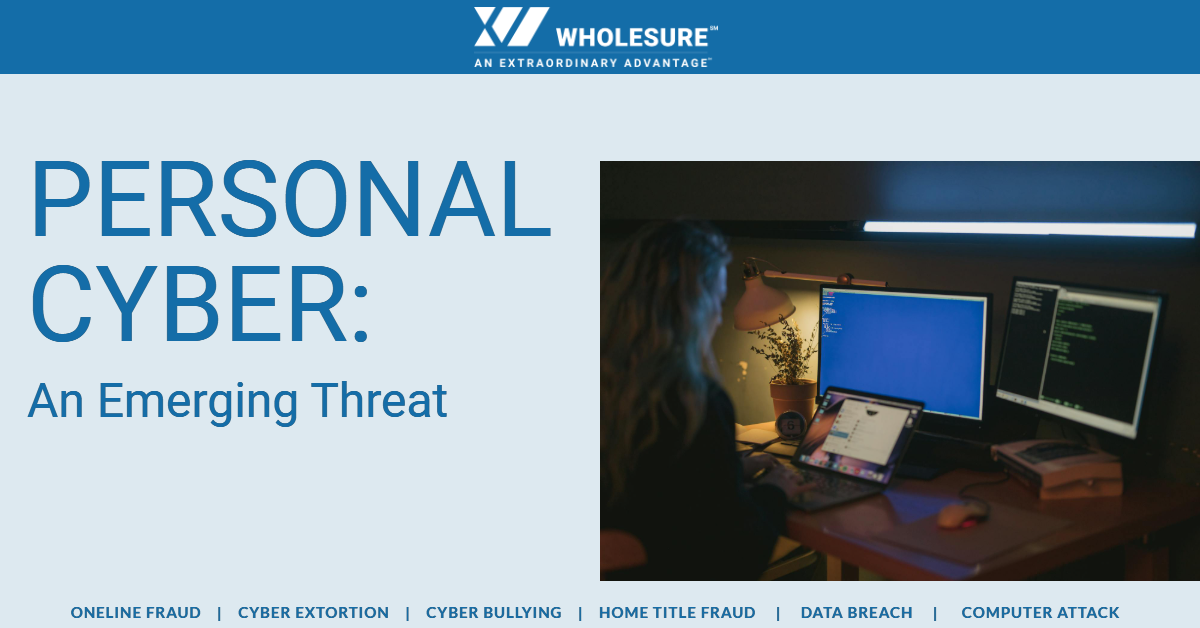Personal Cyber is one of the fastest growing products in the insurance industry. In the past 18 months, we’ve seen capacity double, and policy forms become more broad.
Some of the largest carriers in the cyber insurance marketplace are trying to capitalize on personal cyber opportunities.
This product is quickly becoming a necessary cross-selling opportunity for all agents that insure personal lines. Many agents include personal cyber proposals in their homeowner’s insurance client’s renewal packet. The product was once reserved strictly for high profile individuals and is now available for anyone with a homeowner’s policy.
What is Personal Cyber?
Personal cyber protection offers individuals or families coverage against multiple claims triggers. Some of the most common claims triggers include Data Breach, Identity Theft, Cyber Bullying, Cyber Extortion, and Home Title Fraud. Most primary personal cyber policies can be offered with limits ranging as low as $10,000 and as high as $1,000,000.
Thirty-seven percent of individuals have experienced a virus, hacking incident or other cyber incident in the past five years. Over 60% of individuals believe that they will become a target of an online attack in the next year. This is not a surprise when you consider we are increasingly running our lives from laptops and smartphones: online shopping, online banking and media-streaming. Cyber criminals are hacking devices and spamming us with emails that lead to cybercrime, disrupting our lives and causing financial harm.
Frequently Asked Questions:
Many of the questions we receive regarding personal cyber pertain to how the policy would respond if a personal cyber incident were to occur. Some of the most common concerns relate to the most frequent claims triggers. How could a policy respond to the following claims triggers:
- Online Fraud: Pays for losses resulting from identity theft, phishing schemes, illegal bank and credit card transfers, cryptocurrency theft, forgery and other deceptions.
- Cyber Extortion: Provides professional assistance on how to respond to a ransomware attack and payment of approved ransom payments.
- Cyber Bullying: Pay for the costs of recovering from a cyberbullying attack. From psychiatric counselling services and legal expenses to temporary relocation expenses, social media monitoring and more.
- Home Title Fraud: Provides coverage for costs resulting from an identity theft, including attorney and court filing fees for the recovery of the title.
- Data Breach: Includes costs associated with forensic I.T., legal reviews and notification and recovery services when private non-business data is lost or stolen.
- Computer Attack: Removes malware and restores software on computers, tablets, Wi-Fi routers and other internet access points.
How is Personal Cyber Underwritten?
The cost of a personal cyber insurance policy varies depending on the limit. The pricing is typically set per limit and does not account for common underwriting methods such as claims history or geographic location. Most carriers simply just need the clients’ name, address, email, and phone number to issue a personal cyber policy. Coverage is typically issued with 24 hours of the clients request to bind.
As our lives become more connected through devices and online accounts, the risk of cyber threats continue to grow. Personal cyber coverage is a proactive step to guard one’s digital life, finances, and personal well-being against the rising tide of cyber threats.
About the Author:
Kevin Merchant is the National Cyber Practice Leader of Wholesure. Kevin focuses his efforts on assisting his retail agency partners in finding solutions for their hard-to-place professional liability, management liability, and cyber liability risks. Kevin can be reached at [email protected].

